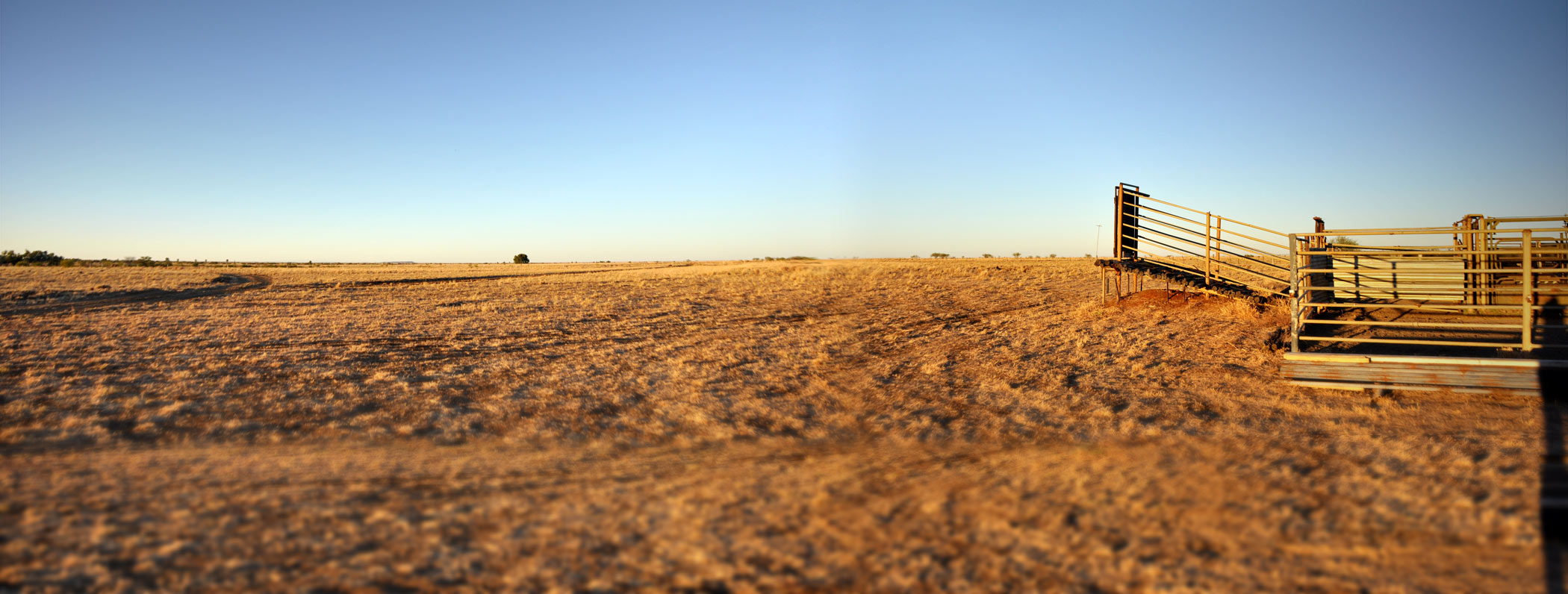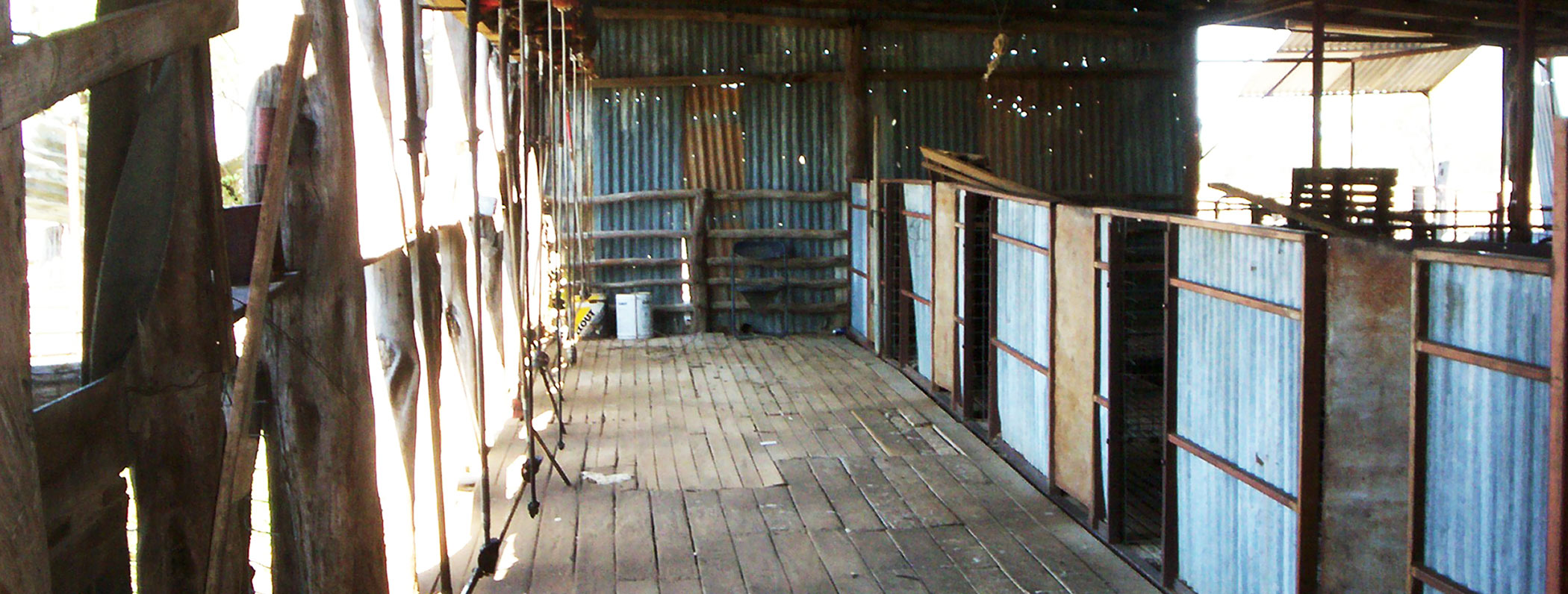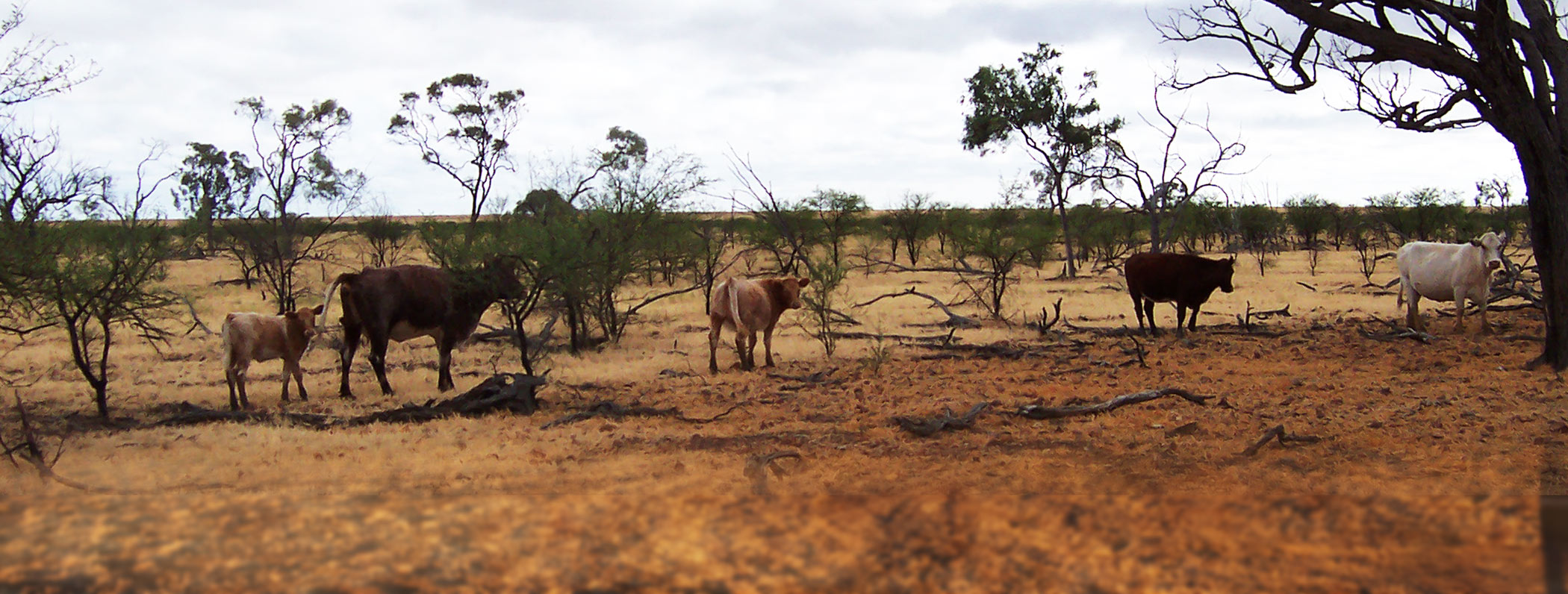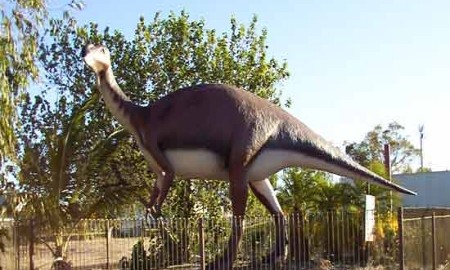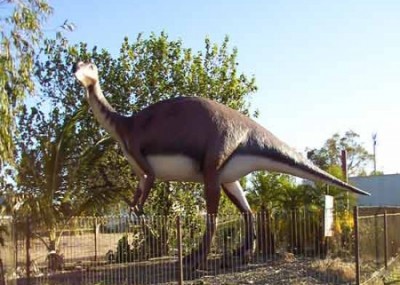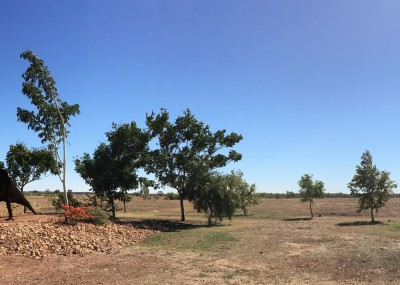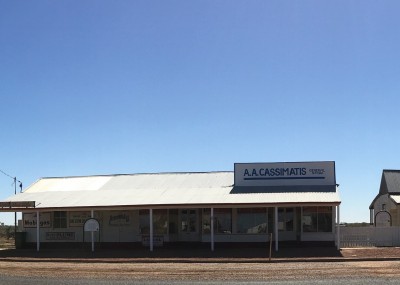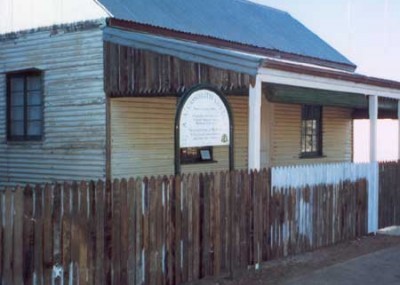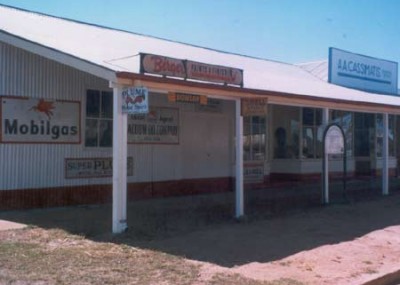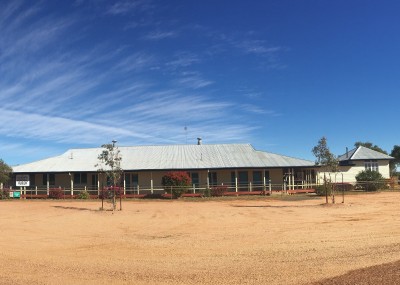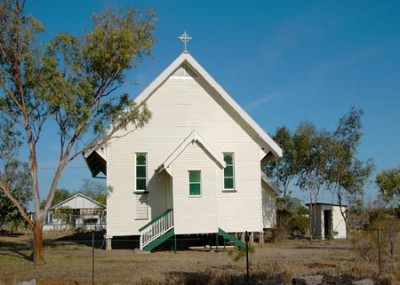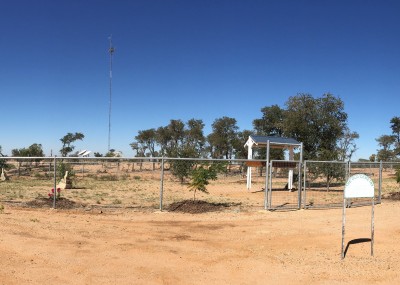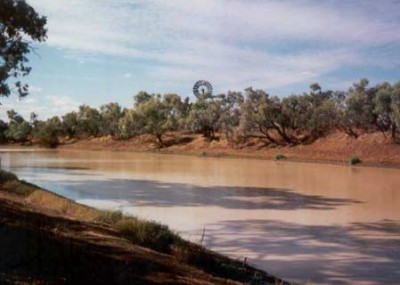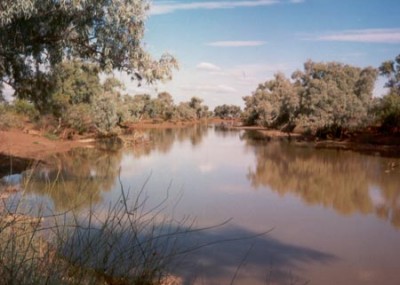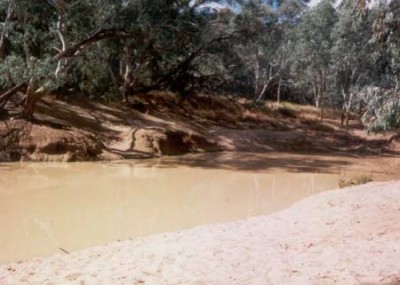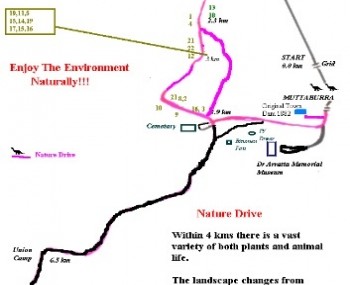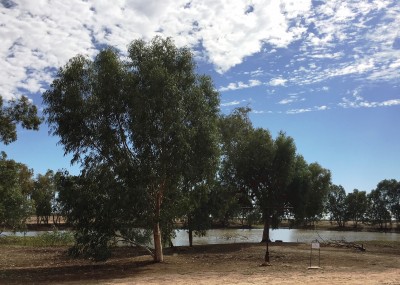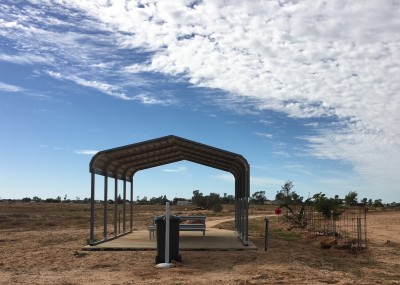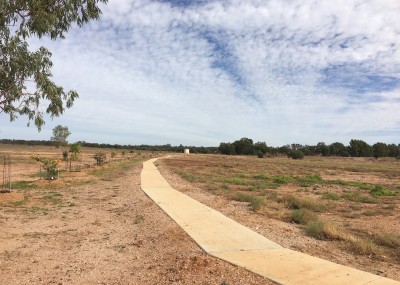Muttaburrasaurus Langdoni
A Replica based on the fossil dinosaur skeleton found by Mr Doug Langdon near Muttaburra in 1963 is situated in the park beside the Muttaburra Memorial Hall, across from Muttaburra Shop & Fuel. The remains of the dinosaur are in the Brisbane Museum where work on the restoration of the skeleton continues. A replica skeleton leg is on display in the Dr Arratta Memorial Museum.
Dr Arratta Memorial Museum
Admission Donation
Contact (07) 4658 7191
An historic hospital display and general museum is situated in the original Muttaburra and District Hospital. It is a memorial to Dr Arratta who spent 35 years in the community and was awarded the MBE for his service.
This large hospital complex served Muttaburra and surrounding districts until the1980’s. Now it houses a Medical Museum, which has been named in honour of Dr Joseph Arratta who ‘served’ the west through the Muttaburra Hospital from 1925 until 1960.
Today these buildings house both medical and hospital displays. The hospital is as it would have been when Dr Arratta left in 1960. Casualty, the operating theatre with sterilizer and plenum ventilation and both maternity and infectious disease rooms are still open. The male ward is fully furnished with made-up beds, meal trays, flowers and bedside radios.
The oldest building in the complex is the weatherboard structure housing the operating theatre. It hosts a display of instruments used in early medicine and in some cases devised by Dr Arratta and one of the locals to make do in an emergency. A fine example of this is the Balkan Traction frame used to treat a fractured femur; constructed by Barry the local mechanic at the time.
Edited from material by Helen Marsh
Cassimatis General Store
Admission Donation
Contact (07) 4658 7191
The Cassimatis General Store, painstakingly restored to its original layout presents an insight into the important role played by the family business in supplying a diverse and numerous range of goods essential to the development and continual operation of outback regions during the early 1900s.
The museum boasts a display of many of its unique fittings:
- an old cash register;
- lolly jars;
- weighing scales;
- a Greek typewriter;
- soft drink machines and
- display stands.
The shelves are stacked with a magnificent range of donated items from the surrounding community, many of which would have been originally purchased from the store.
Be prepared for a walk down memory lane as you encounter anything from Carbide lights to Coolgardie safes and petrol irons. For the younger generation, it is a wonderful opportunity to absorb some of the atmosphere of our early history and the important role played by this Greek family in developing this portion of early Australia.
Edited from material by Helen Marsh
Cassimatis Cottage
Admission Free
Contact (07) 4658 7191
Next door to the Cassimatis General Store is the restored cottage home of George and Stavroola Cassimatis and their five children. Originally a drover’s cottage situated alongside the family’s general store it was built in 1903 and purchased by George Cassimatis in 1934.
The cottage is furnished with much of its original furniture; personal possessions and even items of clothing that belonged to the senior members of the family, as well as many donated artifacts similar or identical to those used by this household.
A tour through this small 5 room cottage will give you an insight into how a large family lived in such a dwelling through the first half of the 1900s. The iron beds, wood stove, fuel lights and kerosene fridge conjure up nostalgic memories and provide an interesting glimpse into our early history.
Edited from material by Helen Marsh
All Saints Church
The little corrugated iron church at Muttaburra has been in existence since 1903. The fact that it was constructed mainly of iron has been the key to its longevity and indeed it its very existence.
Initially church services were held in the Court House or at station homesteads. Mr A Gilbertson who owned an iron and tin foundry at Pontardawe in New South Wales pledged sufficient iron to build the church. This combined with several other generous pledges and gifts saw the completion of the building in November 1903.
Although the church was designed by an architect from Rockhampton in Queensland, it displays many of the characteristics of a British church; namely its steep high-pitched snow roof and the lancet windows without shades. One unique feature is the addition of an extra small room beside the vestry. Several outback churches were constructed with this extra room providing accommodation for the members of the Brotherhood of St Andrew. These Bush Brothers were missionaries for the outback; traveling from town to town by whatever means was available. Today this little room has been fitted out as it would have been at the turn of the 20th Century as a tribute to those brave young men who served God and their countrymen so unselfishly. Photographs and literature on display give a glimpse into their lives and the touching stories surrounding their time spent in outback Australia. Read about the heroic actions of the much-revered ‘Fighting Parson – Hulton Sams’ and the tragic death of the young Guy Maude Roxby serving in this foreign land.
Edited from material by Helen Marsh
Pump Hole
Picnic area on the Thomson River ideal for swimming and fishing for Yellowbelly (Golden Perch), Slipperies (Catfish) and Black Bream.
Broadwater
Situated on a 3.5km stretch on the Landsborough River, the broadwater was first discovered by Landsborough & Buchanan in 1860. The original site of Chinese gardens & Cassimatis Orchards, it features Coolabahs and River Gums that are over 100 years old. Located south of town, the spot is ideal for fishing, skiing, bush walking, bird watching, and camping.
Union Camp & Union Hole
The campsite of approximately 400 shearers during the great shearers’ strike in 1891. All that remains is the old bakers oven. The Union Hole is where the shearers drew water and carted it back to their camp by dray during the strike.
Town Dam
In 1885 a dam was built to provide water for the town and water was carted into town in casks. Later the dam was used as the town’s swimming pool and many of the town’s children learnt to swim here. Muttaburra’s water supply now comes from the great artesian basin but the dam is still a popular spot for it’s peaceful surroundings. It has an excellent cement walkway and a covered area where you can sit and enjoy some bird watching.
Nature Drive
A vast variety of both plant and animal life can be seen within 4 kilometres. The landscape changes from gidgee country to desert sand ridge country and then to black soil channel type country.
You will see examples of the following vegatation –
1. Beefwood – Grevillea striata
A rough barked tree with typical small creamy grevillea flowers. Mostly found in sandy soils. It has durable timber.
2. Leopardwood – Flindersia meculosa
Multi-stemmed juvenile but grows to tree of 12 metres that has a single trunk and spreading crown. The scaly bark is shed in patches leaving the tree with a motley colour of white, orange and light grey so the reason for the name. Usually growing in sandy flats or stony areas and has cream coloured flowers that occur in loose clusters at stem ends.
3. Vine Tree – Ventilago viminalis
A small spreading tree with dark, rough bark. The creamy flowers are small and the fruit only contains one seed and has ‘wings’. Drought resistant and suckers if the roots are exposed or injured.
4. Broom Bush – Apophyllum anomalum
This small tree only grows to about 4 metres and leaves are only found on young stems. Male and female flowers, small creamy and scented, occur on separate plants. The fruit is a black berry. A hardy, drought resistant plant.
5. Bumble Tree – Capparis mithellii
When young a spiny, climbing shrub with small leaves, but grows into a tall tree. The flowers are creamy-white that develop into a large fruit of 6 cm long. The flower is really eye catching and may change to purple with age.
6. Sandalwood – Santalum lanceolatum
This tree grows in the close proximity with other trees as it attaches to their roots. The wood is highly valued for the incense industry. Flowers are small and occur in clusters.
7. Rosewood – Alectryon oleifolius
This tree has small inconspicuous creamy flowers. Growing in sandy soils and lighter clays of the Mitchell grass country. It is a small to medium tree.
8. Whitewood – Atalaya hemigauca
A tall narrow tree growing on a variety of soils. The small creamy-green flowers turn into ‘winged’ fruit, which are yellowish-green. When young the tree and fruit is very toxic to stock.
9. Dead Finish – Archidendropsis basaltica
The plant grows best in red sandy soils but will be found on the edge of black soil. Leaves are palatable for stock. The yellow flowers occur in globular heads.
10. Gidyea – Acacia cambagei
A tree grows to about 10 meters. The flowers are typical acacia flowers – small yellow balls. The tree grows in thick stands. There is a tendance for seedlings to become so thick that they eventually kill the tall old trees. Nothing will grow under or among the Gidyea suckers. Grows usually on black soil.
11. Desert Oak – Acacia coriacea
Straggly tree growing to about 4 metres with yellow globular flower heads consisting of 30 odd flowers. They grow mainly on red sandy soils.
12. Western Bloodwood – Eucalyptus terminalis
One of the smaller gums growing to 10 metres. The bark is scaly. The creamy flowers are rather large 14 mm growing in clusters and are very showery when all out at once sometime covering the whole tree. It grows on sandy soils, usually only a single plant, not growing in clusters.
13. Cabbage Leaf Gum – Eucalyptus grandifolia
A tall graceful tree grows to 15 metres tall with smooth white bark and drooping green foliage. Young leaves are broader then the slender long adults leaves. The creamy flowers are typical of eucalyptus.
14. Silver Oak – Grevillea parallela
Simular to Beefwood, except for its long silver leaves. A small tree growing on sandy soils. Creamy-green grevillea flowers that give a specular showing.
15. False Sandalwood – Eremophila mitchelii
Small bushes with bright green leaves. The white creamy flowers are bell shaped. The plant will grow in many different areas and may be scattered or in dense populations.
16. Conkerberry Bush – Carissa lanceolata
Small, white, tubular, fragrant flowers turn to small soft black fruits. The plant may form thickets and is palatable to browsing stock.
17. Lolly Bush – Clerodendrum floribundum
Really a tall spindly shrub it has creamy-white flowers. The shiny, black fruits are nestled in a deep-red calyx. This plant grows in well-drained soils and suckers freely.
18. Caustic Vine – Sarcostemma viminale australe
A climbing vine of shrub that is poisonous. Cream coloured waxy flowers are star shaped and appear in clusters from the stem joints. The plant contains a milky sap sticky to touch. This plant usually grows in stony areas but is found in amongst gidyea suckers too.
19. Split Jack – Capparis lasiantha
Small tangle vine only growing to about 1.5 metres. The flowers are creamy-yellow. The fruit is 4 cm long and splits when ripe. This plant will often be covered in ants, which protects it from predators like grubs.
20. Mimosa Bush – Acacia farnesiana
Multi-stemmed bush growing to about 2.5 meters tall and has yellow ball likes flowers. Grows well on Mitchell grass downs and is relatively palatable and nutritious for stock.
21. Rose Cottonbush – Cossypium australe
An evergreen shrub that grows to 1 metre. Hibiscuses like flowers are pale purple in summer. Grows in sandy soils.
See the Environment section for more details.
